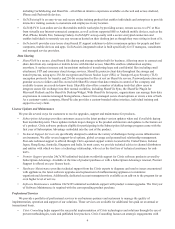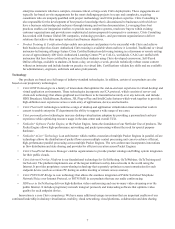Citrix 2012 Annual Report Download - page 20
Download and view the complete annual report
Please find page 20 of the 2012 Citrix annual report below. You can navigate through the pages in the report by either clicking on the pages listed below, or by using the keyword search tool below to find specific information within the annual report.16
• potential market saturation;
• technological change;
• general economic conditions;
• complexities and cost in implementation;
• failure to deliver satisfactory technical support;
• dissatisfied customers; or
• lack of success of entities with which we have a technology relationship.
In addition, there continues to be an increase to the number of alternatives to Windows operating system powered
desktops, in particular mobile devices such as smartphones and tablet computers. Users may increasingly turn to these devices
to perform functions that would have been traditionally performed by desktops and laptops, which in turn may shrink the
market for our Desktop Virtualization products.
If our customers do not continue to purchase our Desktop Virtualization products as a result of these or other factors, our
revenue would decrease and our results of operations and financial condition would be adversely affected. In addition,
modification or termination of certain of our Desktop Virtualization products may cause variability in our revenue and make it
difficult to predict our revenue growth and trends in our Desktop Virtualization products as our customers adjust their
purchasing decisions in response to such events.
We face intense competition, which could result in customer loss, fewer customer orders and reduced revenues and margins.
We sell our products and services in intensely competitive markets. Some of our competitors and potential competitors
have significantly greater financial, technical, sales and marketing and other resources than we do. For example, our ability to
market our Mobile and Desktop products and other future product offerings and upgrades, could be affected by a competitor's
packaging, licensing and pricing scheme for client devices, servers and applications. Further, the announcement of the release,
and the actual release, of new products incorporating similar features to our products could cause our existing and potential
customers to postpone or cancel plans to license certain of our existing and future product and service offerings. In addition,
alternatives for our Mobile and Desktop and Networking and Cloud products directly and indirectly compete with our current
product lines and services. Existing or new products and services that provide alternatives to our products and services could
materially impact our ability to compete in these markets. As the markets for our products and services, especially those
products in early stages of development, continue to develop, additional companies, including companies with significant
market presence in the computer hardware, software, cloud, mobile and related industries, could enter the markets in which we
compete and further intensify competition. In addition, we believe price competition could become a more significant
competitive factor in the future. As a result, we may not be able to maintain our historic prices and margins, which could
adversely affect our business, results of operations and financial condition.
Industry consolidation may result in increased competition.
Some of our competitors have made acquisitions or entered into partnerships or other strategic relationships to offer a
more comprehensive solution than they had previously offered. Additionally, as IT companies attempt to strengthen or maintain
their market positions in the evolving desktop and application virtualization, collaboration and data sharing, mobility, cloud
networking and cloud platform markets, these companies continue to seek to deliver comprehensive IT solutions to end users
and combine enterprise-level hardware and software solutions that may compete with our virtualization, mobility and
collaboration and data sharing solutions. These consolidators or potential consolidators may have significantly greater financial,
technical and other resources than we do and may be better positioned to acquire and offer complementary products and
services. The companies resulting from these possible combinations may create more compelling product and service offerings
and be able to offer greater pricing flexibility or sales and marketing support for such offerings than we can. These heightened
competitive pressures could result in a loss of customers or a reduction in our revenues or revenue growth rates, all of which
could adversely affect our business, results of operations and financial condition.
Actual or perceived security vulnerabilities in our products and services or cyberattacks on our networks could have a
material adverse impact on our business and results of operations.
Use of our products and services may involve the transmission and/or storage of data, including in certain instances
customers' business and personally identifiable information. Thus, maintaining the security of products, computers, computer
networks and data storage resources is a critical issue for us and our customers, as security breaches could result in product or
service vulnerabilities and loss of and/or unauthorized access to confidential information. We devote significant resources to
address security vulnerabilities in our products and services through engineering more secure products and services, enhancing
security and reliability features in our products and services, deploying security updates to address security vulnerabilities and
seeking to respond to known security incidents in sufficient time to minimize any potential adverse impact. Experienced
























